

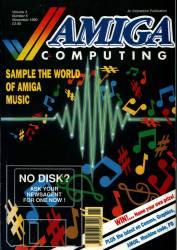
Amiga Computing was one of the first magazines in the UK that solely
covered the Amiga. Launched at the beginning of 1988, it outlived
several magazines launched at the same time. It established a reputation
for its technical coverage, featuring articles that explained how
to use the machine as a work tool, as opposed to a games machine
or a religious artifact.
The magazine underwent its first redesign in 1990, increasing the
page count and expanding their games coverage. However, the game
coverage was always considered to be secondary to the serious aspects
of the magazine. In contrast to Amiga Format and CU Amiga, Amiga
Computing relegated game coverage to the back of the magazine. The
changes were well received and circulation rose - sales figures
indicate the magazine peaked at 60,177 for the July- December 1991
period (ABC).
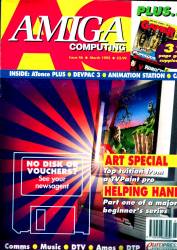
Amiga Computing was rebranded a second time in mid-1992. To compete
with Amiga Shopper, the magazine began to cover specialist subjects,
such as education, digitization and publishing. They also introduced
regular round-ups of application software intended for a specific
purpose (e.g. word processing, text editing, and video editing).
In addition to specialist areas, the magazine also featured regular
tutorials - more than any other Amiga magazine of the time. The
Amiga Almanac section of 1992 explained how to use ARexx, DTV, Music,
AMOS, DTP and communication technologies. The Amiga Mart buyers
guide also educated the reader in potential purchases, and the Amiga
Computing Advice Service (ACAS) aimed to cure readers computer woes.
In contrast, Amiga Format featured only two tutorials on extremely
basic subjects.


By 1994, Amiga Computing had increased its already huge page count
from 148 to 180 pages. The headline on the cover of the January
1994 edition proudly proclaimed a 'new world' of computing was just
around the corner. However, The collapse of Commodore forced the
magazine to sideline technical aspects, to examine the current state
of the Amiga market. The cover of the April 1995 issue questioned
if the Amiga could be resurrected from the corpse of Commodore,
examining the available options in meticulous detail. Although Commodore's
liquidation would eventually result in the collapse of the Amiga
market, the Amiga Computing staff had hit their stride and produced
several amazing issues. The magazines success continued during 1995
when it included a CD-ROM with the May issue. The 'Weird Science
Multimedia Toolkit' was an early at shoveling a large number of
platform-generic data to fill the disc capacity, but it was a welcome
introduction to the opportunities offered by CD-ROM. For the first
time Amiga owners could buy a magazine and CD-ROM that featured
hundreds of photos, modules, fonts, and sound samples. The July
'95 coverdisk also had the first and only fully registered version
of Magic User Interface (v2.2) to appear on a magazine coverdisk.
Although the Amiga Computing staff were optimistic that the Amiga
would be resurrected, the publisher (Europress) were desperate to
leave the magazine business. Many employees and readers were concerned
that the magazine would be canceled. However, these concerns were
unjustified when IDG offered to buy Europress' entire catalogue
as a going concern - Amiga Computing would stay on the shelves.
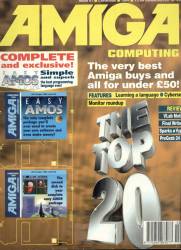
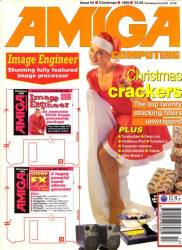
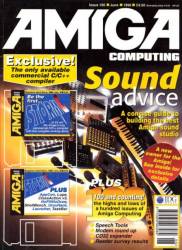
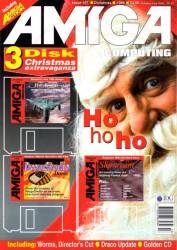

The magazine had been saved by IDG. However, the publisher could
not resurrect the Amiga platform. The page count dropped steadily
during 1996, followed by a reduction in page size to A4. By the
beginning of 1997 the magazine had shrunk to 108 pages, followed
by a steady drop to 100, 84, and finally 68 pages. To reduce costs,
only one coverdisk was given away with the magazine - a far cry
from the CD-ROM of 1995. The quality of writing also dropped and
it became clear that the writers considered the once great magazine
to be a part-time job. In contrast to the decrease in value, the
cover price rose from $4.50 to £4.99. The final issue, dated
October 1997, may have been confused for a pamphlet. The contents
page briefly lamented the state of the Amiga market and indicated
the writers would drown their sorrows in the pub. The final circulation
figures showed the magazine sold just 7,000 issues.


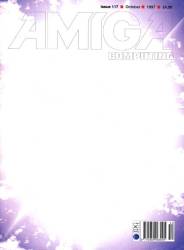
International Edition

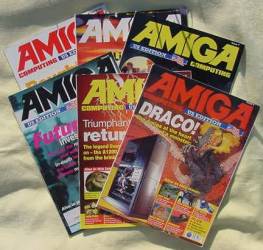
Europress launched a short lived international edition in 1995
to be sold to the American and Greek markets. However, sales were
poor and the magazines were cancelled after a few months.
Games section
The games section of Amiga Computing underwent several redesigns
that changed its title and layout. The first incarnation of the
games section was simply called 'Gamer'. Reviews were surprisingly
critical at the time. Gamers were spoilt for choice and a game had
to contain a unique quality to receive a high score. Reviews were
given a a rating out of 5 for 'Vision' (the look of the game), 'Audio',
'Playability' (how easy it is to get into), and 'Addiction' (do
you want to keep on playing), and a final percentage rating.
The Gamer section was redesigned in 1994 and renamed 'System'.
The layout was altered dramatically, allowing the reader to read
reviews in a non-linear fashion, jumping to particular aspects that
interested them. Graphics of circuit diagrams, showing lines and
gates, linked the various sections of a review. The final rating
could be found in a coloured 'opinion' box at the bottom of the
page. Reviews were shorter and games were generally awarded a higher
score in comparison to the previous iteration. Similar to Amiga
Power, 'System' indicated that 50% was an average game. However,
anything above was worth playing. A 'Bronze Award' was awarded to
games rated 56-66%; 'Silver Award' to games of 66-77%; and 78-99%
earned a 'Gold Award'. Games rated from 90-100% were considered
the best of the best, setting a benchmark for others and worthy
of the 'Platinum Award'. View
Image of Award scheme.
It is likely the 'System' section would have continued to be an
integral part of the magazine for many years. However, the collapse
of the Amiga games market resulted in it being replaced by 'Amiga
Action' in December 1996 (issue 107). Until that point in time,
Amiga Action had been a games magazine
produced by the same publishing house. The Amiga Action supplement
adopted a poor imitation of the game magazines writing style, using
lame jokes to disguise the lack of Amiga games. Game reviews returned
to a linear design, but were poor in comparison to previous gaming
supplements. Games became drastically overrated, disgusting even
the remaining Amiga Action readers. By the final issue (October
1997), the Amiga Action section was just eight pages.
The end of Amiga Computing
It would be simple to say that the Amiga market could no longer
support so many magazine published every month, but this would only
be telling half the story. Although the market could no longer sustain
dedicated games magazines, Amiga Format and CU Amiga magazine were
enjoying a circulation four times higher than Amiga Computing. Amiga
History Guide believes the market could have supported it, but the
publisher wished to move their resources to the growing PC magazine
market. IDG may have purchased Amiga Computing, but they were not
willing to finance the jump to CD-ROM coverdiscs. A conscious decision
was made to cut costs by reducing the number of pages and dropping
a coverdisk. Amiga Computing could not compete with magazines bundled
with CD-ROM discs and one of the longest running Amiga magazines
was closed. However, the web site provided a glimmer of hope that
it would return, in the event that the market improved. The epitaph
on the Amiga Computing web site read:
For almost ten years Amiga Computing published some
of the most informative articles for the Amiga computer. Alas the
Amiga did slip into obscurity with just a handful of users fighting
off the Wintel tyranny.
But perhaps one day it will return to former glory...
Press Releases
Amiga Computing Greek Edition
BACK
Last Update: 24/6/2006
|













